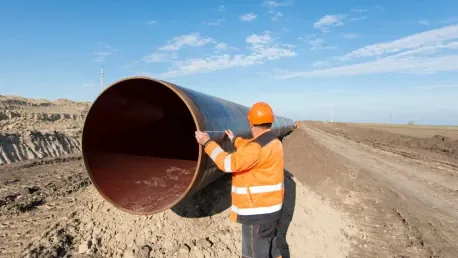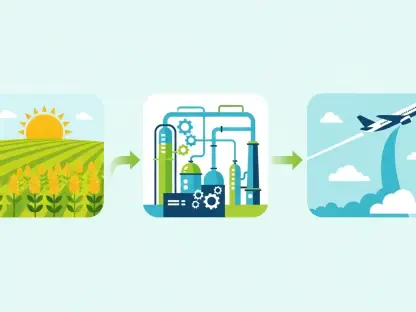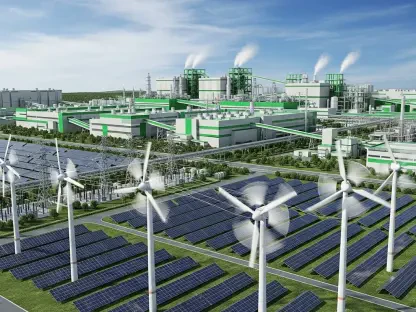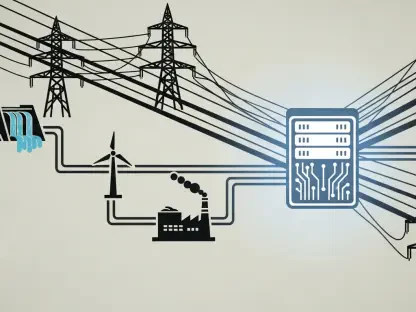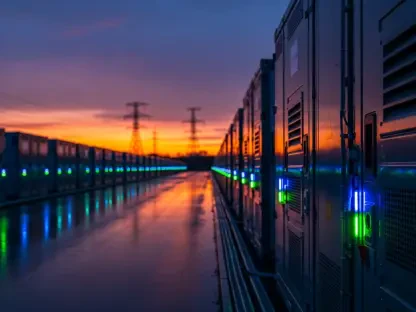The U.S. natural gas market has experienced significant changes due to the substantial expansion of pipeline infrastructure over recent years. This expansion, primarily taking place in 2024, was a strategic move designed to enhance the flow of natural gas from key production regions to various demand centers across the country. The increase in pipeline capacity was expected to reshape the landscape of natural gas prices by addressing previous bottlenecks and ensuring a more efficient supply chain.
Increased Pipeline Capacity
Major Projects and Their Contributions
In 2024, the United States witnessed a remarkable addition of 17.8 billion cubic feet per day (Bcf/d) in new natural gas pipeline capacity, marking the largest increase since before 2022. Prominent projects rolled out during this period included the Mountain Valley Pipeline, the Regional Energy Access Project, and the Louisiana Energy Access Project (LEAP) Phase 3. All combined, these projects added approximately 6.5 Bcf/d of capacity, significantly boosting the takeaway capability from critical production regions such as Appalachia, Haynesville, Permian, and Eagle Ford.
The timing of these projects was critical, addressing the escalating demand and enhancing the natural gas supply routes to prevent shortages and lower transportation costs. By easing the flow of gas from production hubs to consumer markets, these new pipelines contributed to alleviating the constraints that had previously led to price volatility. Additionally, smaller interstate and intrastate projects played a crucial role, adding nearly 3.0 Bcf/d to the overall capacity. The cumulative effect of these enhancements laid the groundwork for transforming the natural gas pricing structure, making it more stable and potentially more affordable to end users.
Expansion to LNG Export Terminals
Another significant aspect of the 2024 pipeline expansion was its impact on capacity to LNG export terminals, particularly in Texas and Louisiana. Five key pipeline projects facilitated an increase of approximately 8.5 Bcf/d in capacity directed at these terminals. Notable among these were the ADCC Pipeline, TC Energy’s Gillis Access project, Venture Global Gator Express’s Gator Express Pipeline, and the Texas Eastern Transmission’s Venice Extension Project.
The increased capacity to LNG export terminals was pivotal, given the growing international demand for U.S. natural gas. By ensuring a smooth and efficient route for natural gas to reach these export terminals, the expansion supported the U.S. position as a leading supplier in the global energy market. Furthermore, the increased capacity helped in balancing domestic supply and demand, which in turn mitigated drastic price fluctuations that could negatively impact consumers. The strategic importance of the Gulf Coast in the export trajectory was underscored by these projects, strengthening the region’s role as a critical export hub.
Governmental Support and Policy Implications
Policy Direction and Its Influence
Governmental support played a significant role in the initiation and completion of these pipeline projects. Under the Trump Administration, a strong emphasis was placed on boosting domestic energy production and infrastructure development. This period saw a revival in enthusiasm for pipeline construction that was previously mired in regulatory and environmental challenges. Energy Secretary Chris Wright highlighted potential projects like the Constitution Pipeline to transport natural gas through New York into New England, indicating a broader governmental strategy to increase energy security and reduce reliance on imports.
This policy direction facilitated quicker decision-making and reduced bureaucratic hurdles, providing a conducive environment for the rapid expansion of natural gas pipeline infrastructure. The administration’s support not only helped in rallying the necessary investments but also ensured that the projects stayed on course, enabling timely completion. The expanded infrastructure was part of the broader energy strategy aimed at making the U.S. more self-reliant while supporting economic growth through job creation and energy exports.
Long-term Strategic Impact
The long-term impact of these policy-driven expansions is profound. By investing in infrastructure and easing regulatory constraints, the U.S. set the stage for future projects that could further enhance the efficiency and reach of natural gas supplies. This strategic alignment with domestic energy production ensured that the country could better navigate market disruptions due to geopolitical tensions or fluctuating global energy demands.
Moreover, the concerted efforts to revive and complete pipeline projects demonstrated a commitment to meeting future energy needs while pursuing sustainable economic policies. The resultant stability in natural gas prices could benefit various sectors, including manufacturing and transportation, which rely heavily on affordable energy. Thus, the government’s role went beyond mere project support, contributing to a stable and predictable energy market that could adapt to evolving global scenarios.
Economic and Market Implications
Influence on Domestic Market Prices
With the substantial increase in pipeline capacity, the U.S. natural gas market witnessed notable stability and potential price reduction. Enhanced infrastructure meant that natural gas could be transported more efficiently and at a lower cost from production regions to demand centers, including residential, commercial, and industrial sectors. This efficiency helped reduce bottlenecks and supply delays, which had previously led to price spikes during peak demand periods.
The direct consequence of these improvements was a more stable pricing environment. Consumers and businesses benefitted from the reduced volatility, which made it easier to plan and budget for energy costs. Additionally, the increased competition among natural gas suppliers, facilitated by better infrastructure, often resulted in a downward pressure on prices. The ripple effect of these changes could be felt across various facets of the economy, highlighting the critical role infrastructure plays in energy market dynamics.
Benefits to Export Markets
On the international front, the expanded pipeline capacity to LNG export terminals allowed the U.S. to bolster its presence as a key global supplier of natural gas. The ability to efficiently transport natural gas to export hubs meant that the U.S. could meet growing global demand with greater ease, ensuring timely deliveries and enhancing its competitiveness in the international market.
This strategic advantage translated to increased revenues and strengthened trade relationships with key importers. Countries in Europe, Asia, and other regions looking for reliable energy sources increasingly turned to the U.S., secure in the knowledge that the enhanced infrastructure supported sustained supply capabilities. The economic benefits extended beyond the energy sector, contributing positively to the U.S. trade balance and fostering international economic ties.
Future Considerations and Conclusion
Addressing Future Energy Needs
The significant expansion of natural gas pipeline infrastructure highlighted in this examination provides a clear roadmap for addressing future energy needs. As the energy landscape continues to evolve, it is crucial to maintain a forward-looking approach that anticipates demand surges and potential supply challenges. Innovative projects, supported by favorable government policies, will play a pivotal role in ensuring that the U.S. remains a leader in energy production and distribution.
Future considerations must also involve a balanced approach to environmental concerns and sustainability. While infrastructure development is essential, ensuring that these expansions do not compromise environmental integrity will be vital. Investments in technology that reduces the environmental footprint and promotes cleaner energy transportation methods could reconcile these two objectives.
Summarizing the Impact
The U.S. natural gas market has undergone substantial changes due to recent expansions in pipeline infrastructure. Primarily occurring in 2024, this expansion was a strategic effort aimed at improving the flow of natural gas from major production areas to various demand centers around the country. By increasing pipeline capacity, it addressed previous bottlenecks, therefore ensuring a more efficient and reliable supply chain. This, in turn, was expected to significantly reshape the landscape of natural gas prices. The increased infrastructure was poised to stabilize prices by enhancing the distribution network’s overall efficiency. The effort to expand pipeline capacity not only improved the flow of natural gas but also ensured that supply could meet growing demand more effectively, reducing the risk of price volatility and fostering a more stable market environment. This infrastructure development marked a significant milestone in the U.S. natural gas industry, promising enhanced energy security and economic growth.
